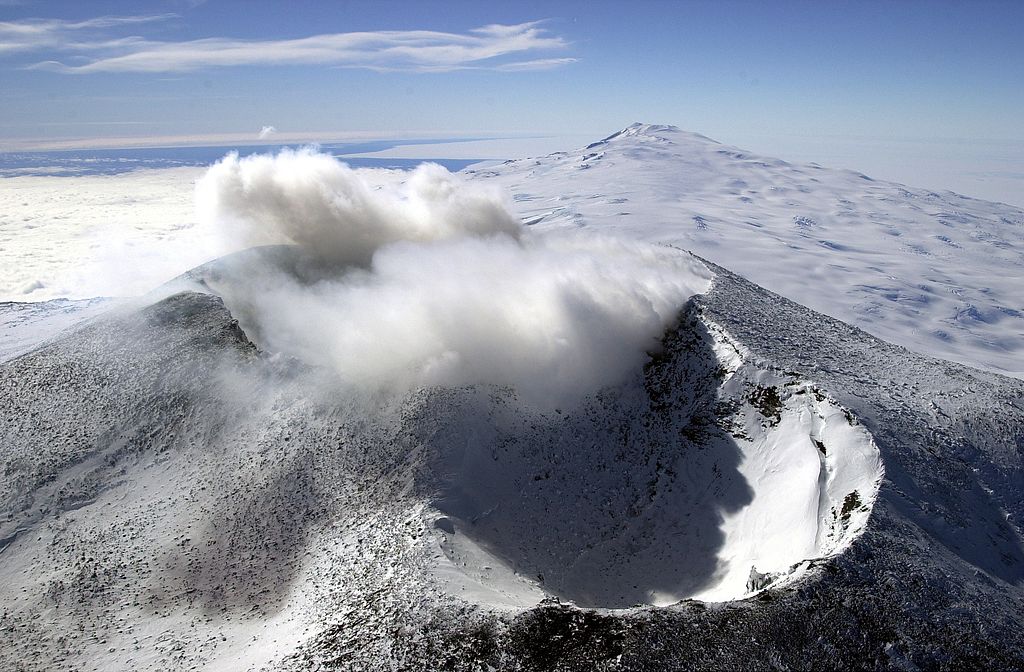Nearly 100 Volcanoes Discovered Beneath Antarctica's Ice
Posted on Categories Discover Magazine

You could say Antarctica sings a song of fire and ice.
The continent’s frigid reputation is well known, but researchers from the University of Edinburgh analyzed radar scans of the West Antarctic Rift System and found 138 volcanoes hiding under the thick ice sheet. Of those, 91 were previously unidentified, they say, and the discovery could change our understanding of how the overlaying ice layer grows and shrinks.
Hidden Volcanoes
The West Antarctic Rift is bounded by the Transantarctic Mountains, stopping just shy of the peninsula and is largely covered by the Ross Ice Shelf. It’s where the seams of the Antarctic Plate are beginning to split, and the continent is pulling itself apart a bit like a piece of taffy. As the continental crust thins, magma can bubble through, causing volcanoes to sprout upward. A similar process is occurring in the East African Rift, an area that served as an important comparison for their analysis. In Antarctica, however, the land is covered by ice that can be more than a mile thick, leaving much of the underlying terrain shrouded in mystery. Our only glimpses come via radar data obtained from aerial surveys conducted over the years.
Using already-existing data from the British Antarctic Survey, the Edinburgh researchers hunted volcanoes by looking for cones. Based on measurements of other volcanoes worldwide, they knew that eruptions usually create cone-shaped mountains with a specific height-to-width ratio. With this knowledge in hand, all they had to do was find the rocky projections under the ice that fit the profile. They assembled a list of these rocky cones and then applied a few additional constraints, like the presence of magnetic and gravitational anomalies, to arrive at their final figure. The study was published by the Geological Society of London.
The distribution of the 91 likely volcanoes roughly aligns with the jagged continental rift, as would be expected. Along with the East African Rift, this stretch of Antarctica is now one of the most volcano-dense regions in the world, according to the researchers. However, not all of them may be active anymore, as the researchers’ data only reveals physical features, and doesn’t track geothermal activity. That region actually sees very few earthquakes, as John Cottle, a geology professor at the University of California, Santa Barbara points out, something that normally correlates with eruptions. It could be that many of the volcanoes are now extinct, he says.
Activity Deep Down
Even if most of the volcanoes no longer spew molten rock, it’s clear that volcanic activity is still occurring, according to a recent study that found a surprising amount of heat flow underneath the glacier. One of Antarctica’s most famous volcanoes, Mt. Erebus, is located in the region and has been active for some 1.3 million years, and Mt. Sidley, the highest volcano in Antarctica, is also nearby.
The presence of glacial volcanoes may sound like cause for alarm in a time when worries of melting ice sheets abound, but the reality is more complex. While thermal activity underneath glaciers can cause them to move faster as the bottom layer melts, it’s never been seen as a major factor in the past. While the discovery of dozens of volcanoes under the ice certainly indicates that Antarctica is more geologically active previously believed, it’s still not known how many are actually likely to erupt soon and what the consequences will be. In fact, the volcanoes themselves could act as a kind of brake by making the terrain more uneven and inhibiting the flow of ice.
“Models have shown that the rate of ice sheet retreat strongly depends on the shape and roughness of the surface beneath the ice. If the rock bed of the ice sheet is smooth, then retreat can proceed rapidly, but if the bed contains lots of topography, like volcanic cones, or craters, then this could slow the rate of retreat a lot,” Cottle says.
If the ice sheet continues to thin, however, the progressive unloading of weight could have a catalyzing effect on volcanic activity. Studies in Iceland indicate that as the ice fades, eruptions become more common. This is both because the rocks are more likely to melt when the pressure is removed and because gases trapped in the magma can get released, spurring eruptions. This could lead to a feedback effect where melting ice causes eruptions, which in turn melt more ice and continue the cycle.